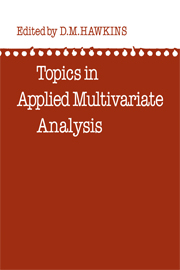Book contents
- Frontmatter
- PREFACE
- CONTRIBUTORS
- Contents
- CHAPTER 1 DISCRIMINANT ANALYSIS
- CHAPTER 2 COVARIANCE STRUCTURES
- CHAPTER 3 THE LOG-LINEAR MODEL AND ITS APPLICATION TO MULTIWAY CONTINGENCY TABLES
- CHAPTER 4 SCALING A DATA MATRIX IN A LOW-DIMENSIONAL EUCLIDEAN SPACE
- CHAPTER 5 AUTOMATIC INTERACTION DETECTION
- CHAPTER 6 CLUSTER ANALYSIS
- INDEX
CHAPTER 6 - CLUSTER ANALYSIS
Published online by Cambridge University Press: 05 November 2011
- Frontmatter
- PREFACE
- CONTRIBUTORS
- Contents
- CHAPTER 1 DISCRIMINANT ANALYSIS
- CHAPTER 2 COVARIANCE STRUCTURES
- CHAPTER 3 THE LOG-LINEAR MODEL AND ITS APPLICATION TO MULTIWAY CONTINGENCY TABLES
- CHAPTER 4 SCALING A DATA MATRIX IN A LOW-DIMENSIONAL EUCLIDEAN SPACE
- CHAPTER 5 AUTOMATIC INTERACTION DETECTION
- CHAPTER 6 CLUSTER ANALYSIS
- INDEX
Summary
INTRODUCTION
The urge to classify objects must be recognized both as a basic human attribute, and as one of the cornerstones of the scientific method. A sorting and classification of a set of objects is the necessary prerequisite to an investigation into why that particular classification works to the extent that it does.
The most striking example of this process is in biology. The Linnaean system of classification predated Darwin by a century, but the very success of a scheme which was able to describe biological species as if they were the leaves of a tree invited a model to explain such an effect. The theory of evolution provided just such a model.
Much later, the same evolutionary model and its consequent tree structure have been used in linguistics to study the evolution of languages. These two applications illustrate two possible uses for cluster analysis. The first is to take a set of objects with particular interobject similarities and classify them “blindly”. As a result of this, one can study the resultant typology, and use it to build up models to explain the typology. The second use is to take a set of objects with a known form of typology (e.g. an evolutionary tree) and use an appropriate method to classify the objects.
There are other uses of cluster analysis in which the existence of a “real” typology is not presumed, but the analysis provides a convenient summary of a large body of data.
- Type
- Chapter
- Information
- Topics in Applied Multivariate Analysis , pp. 303 - 356Publisher: Cambridge University PressPrint publication year: 1982
- 24
- Cited by



